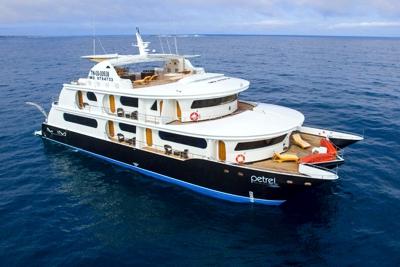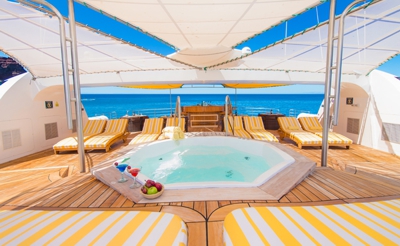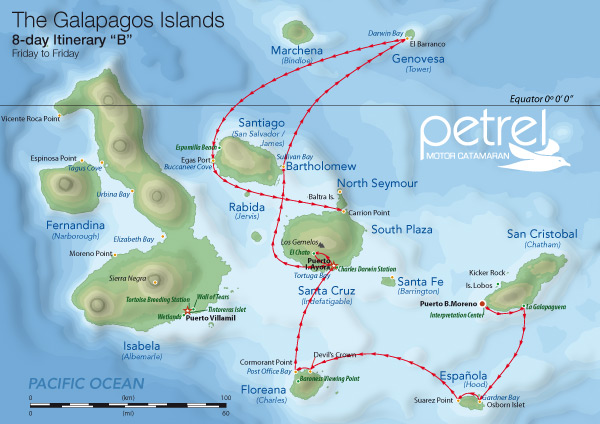

Destinations
Experiences
 |
L A
D A T C O T O U R
S |
 |
||||||||
| HOME | South America | Falkland Islands | Antarctica | Unique Destinations |
Unique Experiences |
Newsstand | ||||
 |
GALAPAGOS ISLANDS
Petrel
|
 |
||||||
|
Itinerary "B" |

Day 1 (Friday)
FROM QUITO OR GUAYAQUIL TO SAN CRISTOBAL
Assistance will be provided for you when you arrive to the airport by one of our representatives after you have landed.AM. San Cristobal Island
You will arrive at San Cristobal Island in the morning. After passing through immigration and baggage claim you will be met by Petrel staff and transferred to the yacht. You will be shown to your cabin where you will have some time to settle in before lunch and a welcome briefing.PM. Interpretation Center (San Cristobal Island)
The Interpretation Center was opened in 1998 as a phase of the project “Interpretation and Environment Education Project.” Visitors enjoy expositions on natural history, human history, and conservation. The conservation efforts represent the movement to protect the wildlife and natural environment through means of population and tourist control. The Interpretation Center has an outdoor stadium, audio-visual equipment, and meeting rooms.
|
Highlights: |
Interactive exhibits |
|
Possible Activities: |
Short walk |
|
Type of Landing: |
Dry landing |
|
Difficulty: |
Easy |
PM. La Galapaguera (San Cristobal Island)
A visitor site in the southeast part of San Cristobal Island that can be reached in roughly one hour by road from Puerto Baquerizo Moreno. On the trees and shrubs surrounding the site, you may see land birds like warbler, finches and mockingbirds, and on the trails, Giant Tortoises.
|
Highlights: |
Giant Tortoises in captivity, land birds |
|
Possible Activities: |
Short walk |
|
Type of Landing: |
Dry landing |
|
Difficulty: |
Easy |
Day 2 (Saturday)
AM. Gardner Bay (Española Island)
Gardner Bay, on the eastern side of the island, is the breeding site of nearly all of the world´s 12,000 pairs of Waved Albatrosses. It has an ample white sandy beach with a myriad of sea lions, perfect for relaxing. Its rocky shores make this site a great place for diving and snorkeling.
|
Highlights: |
White sandy beach, sea lions, mockingbirds; snorkeling: colorful fish, sea lion nursery |
|
Possible Activities: |
Snorkeling, dinghy ride, kayaking, short hike of (0.6 mi/1 km) |
|
Type of Landing: |
Wet landing |
|
Difficulty: |
Easy |
AM. Osborn Islet (Española Island)
After landing, you can walk across a lovely white sand beach amongst a busy sea lion colony or dive into the water to swim with sea lion pups. This small island is a marine visit where you can enjoy fantastic snorkeling and swimming.
|
Highlights: |
White sandy beach, sea lions, and mockingbirds. |
|
Possible Activities: |
Snorkeling, dinghy ride, kayaking, and short hike of (0.6 mi / 1km) |
|
Type of Landing: |
Wet Landing |
|
Difficulty: |
Easy |
PM. Suarez Point (Española Island)
This area is great for spotting Blue-footed Boobies, albatrosses and Nazca Boobies. A beautiful site on the ocean front, the large Waved Albatrosses use the cliff as a launching pad. The famous attraction is the magnificent blowhole, spurting water high into the air. This site presents wonderful photograph opportunities.
|
Highlights: |
Hood Mockingbird, Nazca Boobies, Waved Albatross, Red-billed tropicbirds, lava lizards, Galapagos Hawk, Blue-footed Boobies, blow hole, amazing landscape |
|
Possible Activities: |
Hike (1.9 mi/3 km) |
|
Type of Landing: |
Dry Landing |
|
Difficulty: |
Difficult |
Day 3 (Sunday)
AM. Cormorant Point (Floreana Island)
This site hosts a large flamingo lagoon where other birds such as common stilts, White-cheeked Pintails can also be seen. The beaches on this island are distinct: The “Green Beach” named so due to its green color, which comes from a high percentage of olivine crystals in the sand, and the “Four Sand Beach” composed of white coral.
|
Highlights: |
Flamingoes, green-colored beach |
|
Possible Activities: |
Dinghy ride & hike (1.2 mi /2 km) |
|
Type of Landing: |
Wet landing |
|
Difficulty: |
Easy |
AM. Devil’s Crown (Floreana Island)
One of the best snorkeling sites in the Galapagos, this volcanic crater has been eroded by the waves leaving the northern and southern sides poking out of the water. The coral reef in the middle is perfect for attracting marine life. Snorkelers enjoy the variety of marine life and exciting currents that rush through the crown, creating an exhilarating experience.
|
Highlights: |
The best snorkeling site in Galapagos Islands with sharks, rays, rock formations, lots of tropical fish. |
|
Possible Activities: |
Snorkeling |
|
Type of Landing: |
No landing |
|
Difficulty: |
Moderate/difficult |
PM. Post Office Bay (Floreana Island)
In the 18th century whalers passing through the islands placed a wooden barrel on Floreana Island for use as an unofficial mail box. The tradition continues today as visitors leave addressed postcards in the barrel and sort through left mail to deliver at home.
|
Highlights: |
Barrel Post Office, nice sandy beach |
|
Possible Activities: |
Short hike (less than 0.6 mi/1 km) & snorkeling |
|
Type of Landing: |
Wet landing |
|
Difficulty: |
Easy |
Day 4 (Monday)
AM. Charles Darwin Station (Santa Cruz Island)
The Charles Darwin Research Station is home to turtles ranging from 3-inches (new hatchlings) to 4-feet long. Sub-species of turtles interact with one another and many of the older turtles are accustomed to humans, stretching out their heads for a pet. The babies are kept until they are about four years old and strong enough to survive on their own.
|
Highlights: |
Giant Tortoises in captivation |
|
Possible Activities: |
Walking |
|
Type of Landing: |
Dry landing |
|
Difficulty: |
Easy |
PM. Highlands (Santa Cruz Island)
Here at the Highlands, you can walk along a path, observing the hills, ferns, volcanoes, and rich wildlife. This area is home to giant tortoises, forest, mockingbirds, Bahama ducklings, White-cheeked Pintail ducklings, Darwin finches, and many other species.
|
Highlights: |
Wild turtles, tortoises breeding center. |
|
Possible Activities: |
Hike (1.5 mi/ 2 ½ km) |
|
Type of Landing: |
Dry landing |
|
Difficulty: |
Moderate (Long) |
Day 5 (Tuesday)
AM. Sullivan Bay (Santiago Island)
Located southeast of Santiago Island, Sullivan Bay is of great geological interest. The area is covered by Pahoehoe lava flows combined with A’A lava. It was very active 200 years ago. This flow is geologically very young. The magma formed is flat, but the movement of underground lava, the rapid cooling and other eruptions led to the break in many places.
|
Highlights: |
Pahoehoe lava flows, which have hardened in accordion like formation. Small glass-like bubbles of lava can be found, called "hornitos". Swimming with sea lions and other wildlife from the shore is a lovely way to finish off the tour. |
|
Possible Activities: |
Hike (1.3 mi / 1 1/2 km) swimming and snorkeling. |
|
Type of Landing: |
Dry landing |
|
Difficulty: |
Moderate |
PM. Pinnacle Rock (Bartholomew Island)
Home of the famous Pinnacle Rock, Bartholomew consists of an extinct volcano with a variety of red, orange, black and even green volcanic formations. A trail of stairs leads to the summit of the volcano, boasting one o the best views of the islands. The beach is perfect for snorkeling and possible sightings of the Galapagos Penguin.
|
Highlights: |
Pinnacle rock, panoramic view, moonlike landscape, penguins, pioneer plants, lava cactus; snorkeling: penguins, reef sharks, rays, and great colorful fish. |
|
Possible Activities: |
Dinghy ride, snorkeling & hiking (1.2 mi/ 2km) |
|
Type of Landing: |
Dry and wet landings |
|
Difficulty: |
Moderate/difficult. Walk up to the top of volcano 114 meters, 375 wooden steps |
Day 6 (Wednesday)
AM. Darwin Bay (Genovesa Island)
This white-sand coral beach heads a half mile trail (.75km) that winds through mangroves filled with land birds. Nazca Boobies, Red-footed Boobies, and Swallow-tailed Gulls can be spotted here. Further down the path are tidal pools where sea lions swim playfully. At the end is a spectacular view off a cliff.
|
Highlights: |
Nazca Boobies, Red- footed Boobies, Swallow-tailed Gulls, mangroves, coral pebbles beach, snorkeling: rays, colorful reef fish and hammerhead sharks |
|
Possible Activities: |
Hiking (0.9 mi/1.5 km), snorkeling, kayaking & dinghy ride |
|
Type of Landing: |
Wet landing. |
|
Difficulty: |
Easy / Moderate |
PM. El Barranco (Genovesa Island)
Also known as El Barranco, Prince Phillip's Steps' steep, rocky paths leads up to a high cliff-face. A marvelous view can be appreciated from here. This site is also home to Palo Santo vegetation as well as Red-footed Boobies, Short-eared Lava Owls, Galapagos Swallows, and Galapagos Doves.
|
Highlights: |
Red-footed Boobies, Short-eared Lava Owls, storm-petrels, Galapagos Doves |
|
Possible Activities: |
Hiking (0.9 mi/2 km) |
|
Type of Landing: |
Dry, difficult landing |
|
Difficulty: |
Moderate |
Day 7 (Thursday)
AM. Egas Port (Santiago Island)
Also known as James Bay, Egas Port is home to the curious Galapagos Hawks and Quick-footed Galapagos Lava Lizards. The trail leads to a coastline with gorgeous tide pools and grottos full of fauna. Here the Galapagos Fur Sea Lions bathe in the sun. This is also a great snorkeling site.
|
Highlights: |
Fur sea lions, Galapagos Sea Lions, tidal pools and “grottos”, Galapagos Hawk, oyster catchers, marine iguanas, finches; snorkeling: reef sharks, turtles, rays, nice underwater formations. |
|
Possible Activities: |
Snorkeling, hiking (1.25 mi/2 km) |
|
Type of Landing: |
Wet landing |
|
Difficulty: |
Easy / Moderate |
PM. Espumilla Beach (Santiago Island)
Espumilla Beach is a popular place for marine iguanas and Sally Lightfoot Crabs. The crabs attract the hunting herons, performing the dance of predator and prey. With an abundance of marine life including octopi, moray eel, and shark, snorkeling is highly recommended.
|
Highlights: |
Snorkeling |
|
Possible Activities: |
Snorkeling and swimming |
|
Type of Landing: |
Wet landing |
|
Difficulty: |
Easy |
PM. Buccaneer Cove (Santiago Island) Years ago Buccaneer Cove was a safe haven where pirates in the 1600 and 1700’s would stake out on the Northwestern side of Santiago Island. Sea turtles now take the pirates place and dig their nests for their eggs near the Mangrove trees. It is a great location for snorkeling and many marine birds and sea lions can be found here.
|
Highlights: |
Historical site, rock formations; tropical fish, turtles, sting-rays while snorkeling |
|
Possible Activities: |
Hiking, snorkeling |
|
Type of Landing: |
Wet landing |
|
Difficulty: |
Easy/Moderate |
Day 8 (Friday)
AM. Carrion Point (Santa Cruz Island)
Carrion Point creates a sheltered lagoon with beautiful, turquoise water. During this visit you can snorkel and see a variety of fish, rays and perhaps the harmless white-tip reef sharks. The point is on the north coast of Santa Cruz Island at the entrance of Channel of Itabaca.
|
Highlights: |
Snorkeling |
|
Animals: |
Fish, rays, white-tip reef sharks |
|
Type of Landing: |
None |
|
Difficulty: |
Easy |
AM. Transfer to the airport (Baltra Island)
Please keep in mind that on departures days, your morning visit will be early and short since we need to be prepared before heading back toward the airport for your returning flight to Ecuador’s mainland.
IMPORTANT:
Itineraries and activities subject to change without prior notice. Depending on weather conditions and water currents, some wildlife described above may not be visible